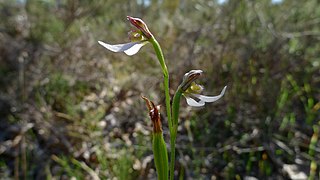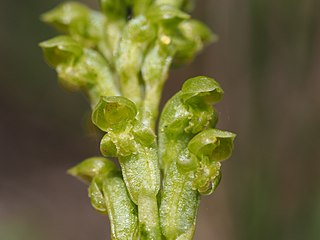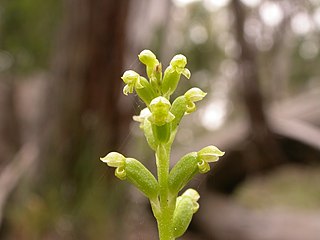
Prasophyllum, commonly known as leek orchids, is a genus of about 140 species of flowering plants in the orchid family, Orchidaceae and is found in Australia and New Zealand. The Australian species are found in all states but have not been recorded in the Northern Territory. The common name arises from their having a hollow, leek- or onion-like leaf. Some species only flower after summer fires and have flowers similar to those of Xanthorrhoea which flower at the same time, suggesting that they employ the same pollinating insects. Leek orchids are similar to those in the genus Genoplesium except that the free part of the leaf is cylindrical and the labellum has a solid connection to the column. They range in size from the little laughing leek orchid at about 15 cm (6 in) to the king leek orchid which grows up to 2 m (80 in) tall.

Eriochilus, commonly known as bunny orchids, is a genus of flowering plants in the orchid family, Orchidaceae that is endemic to Australia. Orchids in this genus are distinguished from those in the similar Caladenia by having a glabrous leaf and a densely woolly labellum. Species occur in south-west Western Australia, South Australia, Queensland, New South Wales, the Australian Capital Territory, Victoria, and Tasmania. Their common name alludes to their prominent ear-like lateral sepals.

Microtis media, commonly known as the common mignonette orchid, is a species of herbaceous plants of the family Orchidaceae endemic to the south–west of Western Australia. It has a single tubular leaf and up to one hundred small, yellowish green flowers arranged along the flowering stem.

Microtis unifolia, commonly known as the common onion orchid, is a species of orchid occurring from south China to Japan, Malesia, and Australasia to the Southwest Pacific. It has a single green leaf and up to one hundred small green or yellowish-green flowers. A common, widespread orchid which is easily grown in pots and is sometimes a weed in plant nurseries.

Genoplesium commonly known as midge orchids, is a genus of about 50 species of flowering plants in the orchid family, Orchidaceae and is found in Australia, New Zealand and New Caledonia. Midge orchids are terrestrial herbs with a single leaf at the base of the plant. They are similar to orchids in the genus Prasophyllum in that plants without flowers have a hollow, onion-like leaf. The flowers are small but often scented and attractive to their insect pollinators. There is disagreement about which species belong to this genus and some taxonomists suggest that most belong in the genus Corunastylis.

Caleana, commonly known as duck orchids, is a genus of flowering plants in the orchid family, Orchidaceae that is found in Australia and New Zealand. The Australian species are found in all states but have not been recorded in the Northern Territory. Duck orchids have a single leaf and one or a few, dull-coloured, inconspicuous flowers. Most species are found in Western Australia but one species occurs in eastern Australia and one occurs in eastern Australia and New Zealand. Orchids in this genus as well as the hammer orchids (Drakaea) are pollinated by male thynnid wasps.

Microtis parviflora, commonly known as the slender onion-orchid, is a species of orchid which is native to Australia and New Zealand. It occurs in all states of Australia but is not known from the Northern Territory and may not occur in Western Australia. As with others in the genus, it has a single erect, smooth, tubular leaf and up to eighty flowers on an erect flower spike.

Microtis media subsp. media, commonly known as the common mignonette orchid, is a species of orchid which is endemic to the south–west of Western Australia. It is a common, widespread orchid with a single smooth, tubular leaf and a flowering spike with up to one hundred small green flowers. It differs from Microtis media subsp. densiflora in the shape of its flower spike and the shape of its labellum.
Microtis media subsp. densiflora, commonly known as the dense mignonette orchid, is a species of orchid which is endemic to the south–west of Western Australia. It has a single smooth, tubular leaf and a flowering spike with up to one hundred and fifty small yellowish-green flowers. It differs from Microtis media subsp. media in the shape of its flower spike and the shape of its labellum.
Microtis quadrata, commonly known as the south coast mignonette orchid or south coast onion orchid, is a species of orchid endemic to south-west coastal areas of Western Australia. It has a single thin, hollow, onion-like leaf and up to one hundred small, pale green flowers. This onion orchid grows on low mounds in swamps, often with other species of mignonette orchids, and flowers much more prolifically after fire.
Microtis eremaea, commonly known as the slender mignonette orchid or inland onion orchid is a species of orchid endemic to the south-west of Western Australia and western South Australia. It has a single thin, hollow, onion-like leaf and up to fifty small greenish-yellow flowers. The flowers have a distinctive heart-shaped labellum and the orchid generally grows in more inland areas than most other onion orchids.
Microtis eremicola, commonly known as the desert mignonette orchid or dryland onion orchid, is a species of orchid endemic to the south-west of Western Australia. It has a single hollow, onion-like leaf and up to fifty small, dull green to greenish-yellow flowers. This onion orchid is common in soil pockets on granite outcrops in inland areas, mostly between Hyden and Balladonia.
Microtis familiaris, commonly known as the coastal mignonette orchid or coastal onion orchid is a species of orchid endemic to the south-west coastal region of Western Australia. It has a single hollow, onion-like leaf and up to twenty small, green to greenish-yellow, sweetly scented, widely spaced flowers. It often grows with large populations of other Microtis orchids but only flowers after fire.
Microtis globula, commonly known as the globular mignonette orchid or globular onion orchid is a species of orchid endemic to the south-west coastal region of Western Australia. It has a single hollow, onion-like leaf and up to thirty five small greenish-yellow, almost globe-shaped flowers. It often grows in large colonies but only flowers after hot fires the previous summer.

Microtis oblonga, commonly known as the sweet onion orchid, is a species of orchid endemic to south-eastern Australia. It has a single hollow, onion-like leaf and up to fifty scented, bright green flowers. It is considered by some Australian authorities to be synonymous with Microtis rara.
Microtis rara, commonly known as the scented onion orchid, is a species of orchid endemic to Australia, with the exception of the Northern Territory. It has a single hollow, onion-like leaf and up to fifty small green or yellowish-green, scented flowers. It is similar to Microtis oblonga and some authorities regard the two as being one species.
Microtis graniticola, commonly known as the granite mignonette orchid or granite onion orchid is a species of orchid endemic to the south-west of Western Australia. It has a single thin, hollow, onion-like leaf and up to sixty small green to greenish-yellow flowers. It grows in soil pockets on granite outcrops, especially where the soil receives run-off during rainy weather.

Microtis orbicularis, commonly known as the dark mignonette orchid, is a species of orchid endemic to southern Australia. It has a single thin, more or less hollow, onion-like leaf and up to fifty small yellowish-green and red flowers. The plants grow in winter-wet areas, often in shallow water and unlike the similar M. cupularis do not turn black as they dry.
Microtis pulchella, commonly known as the beautiful mignonette orchid or beautiful onion orchid, is a species of orchid endemic to the south-west of Western Australia. It has a single hollow, onion-like leaf and up to twenty five white, thinly textured flowers with a slight perfume. It only flowers after fire and only sometimes produces short, thread-like leaves in the absence of fire.
Robert J. "Rob" Bates is an Australian botanist, plant collector, and illustrator.















